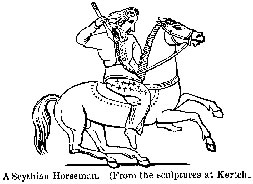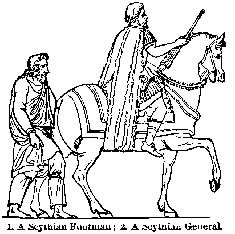Many inhabitants of Israel’s capital city,
Samaria, were taken to the cities of the Medes (II Kings 17:6). We will begin
our search by looking for a group of people who were not physically present in
Media before the fall of Samaria. One historical account records that Assyria’s
King Esarhaddon in 674 B.C. was confronted by an alliance of “Mannaean, Median,
and newly-arrived Cimmerian forces.”4 (Emphasis added) The
“newly-arrived” Cimmerians were the Israelite Samarians who had been settled
among the Medes only a few decades earlier. Webster’s New World Dictionary
states that “Cimmerian” is pronounced “Si-mer-e-en;”5 the consonants of
“Samarian” and “Simereen” are a perfect match. That these “Cimmerians” were
“recent arrivals” in Media adds weight to their identification as Israelite
captives from the city of Samaria.
The Israelites who migrated to the Black
Sea region became known as “Scythians.” The Encyclopedia Britannica
records the Scythians as first being present in Eurasian locations in the
seventh century B.C.6 The Encyclopedia Americana adds:
“The Scythians...are those tribes that
occupied this territory [the region north of the Black Sea] from about 700
B.C.”7 (Emphasis added)
Another account of the Scythian arrival in
the Black Sea region is found in The Scythians, by Tamara Talbot
Rice, which states:
“The Scythians did not become a
recognizable national entity...before the eighth century B.C...By the
seventh century B.C. they had established themselves firmly in southern
Russia... Assyrian documents place their appearance...on the shores of Lake Urmia [just south of Armenia] in the time of King Sargon (722-705 B.C) a
date which closely corresponds with that of the establishment of the first
group of Scythians in southern Russia.”8 (Emphasis added)
These accounts are all consistent with the
historical records cited in chapter two that the Israelites migrated to the
Black Sea area toward the end of the eighth century B.C. Rice’s account
indicates the Black Sea Scythians arrived in southern Russia via a route that
included territory south of Armenia in 722-705 B.C. That is exactly the time
period the Israelites were migrating from their homeland, and it also indicates
the Scythians originated in a former homeland south of Armenia. That place was
Palestine, the location of the old kingdom of Israel.
Later in this chapter, we will see other
Scythians came to live far to the east of the Black Sea Scythians. Tamara Rice’s
book includes a map showing that the burial sites of these “related clans” of
the Scythians have been found as far eastward as the Pazirik/Altai region where
the old Soviet Union joined the western edges of China and Mongolia.9
The opening of a burial mound of these
eastern Scythians was the subject of an article in the October, 1994 issue of
National Geographic magazine. It had the following commentary:
“The Pazyryks thrived in these
steppes...in the sixth through the second centuries B.C. They were horsemen...[and] shepherds...Dozens of such tribes rose on the steppes of Eurasia in
this era, creating a deceptively uniform culture labeled Scytho-Siberian...The
Greek historian Herodotus faithfully detailed much of the life of the
Scythians, a powerful, semi-nomadic people who lived north of the Black Sea
between 800 B.C. and 100 B.C.”10
A female mummified in the burial vault
must have been a prominent Scythian as she was buried with several horses and
gravegoods with gold ornamentation. An earlier excavation in the area had
yielded “two skeletons with European features” who were buried with weapons and
ten horses. These eastern Scythians were one of many clans on the steppes
related to the Scythians of the Black Sea region. The fact that some of their
burial mounds yield skeletons “with European features”11 will become
increasingly important later in this chapter and in the next book in this
series.
The Scythians were frequently called the “Saka,” or “Sacae.” The Encyclopedia Britannica states that the
terms:
“Saka [Sacae] and Scyths...were
regarded as synonymous.”12 (Emphasis added)
The Greek story of Xenophon mentions the
“Sacians” of Asia had “suffered very severely” at the hands of the Assyrians,13
and a Roman writer, Pliny, stated the Scythians were “descended from slaves.”14
These accounts can only describe the Israelites: they bore the name of “Isaac”
(“Sac”-ians), the Israelites truly were descended from a race of slaves (freed
from Egypt in the Exodus), and they had suffered the complete destruction of
their old kingdom of Israel at the hands of Assyria.
It is very significant that the Scythians
were known as Sacae or Saka. As cited earlier, Genesis 21:12 promised that
Abraham’s future descendants would be known by the name of Isaac. The ancient
Hebrew language did not list vowels; therefore, the name Isaac would be
represented by the consonants S-C or S-K. Sac-ae is the word Isaac with the
Latin plural “ae” attached. That these “ Sacae” are recorded as living near the
Black Sea soon after many Israelites migrated there supports the contention that
they were relocated Israelites.
Speculation that the Scythians originated
in the interior of Asia is clearly refuted not only by the above account of
Tamara Rice, but also by the images found on Scythian artifacts. A Russian art
book (translated into English) reproduces many examples of Scythian artwork
showing Scythians with bearded, Semitic features, not Mongoloid features.15
The McClintock and Strong Cyclopedia reproduces images of a
Scythian family and a Scythian horseman, footman and general.16 All
depict Scythians with obvious Caucasian and Semitic features, indicating that
their origin was in the Fertile Crescent, not the interior of Asia.
Not all ancient people bearing the name
“Scythian” were descended from the ten tribes of Israel. The term “Scythian”
was sometimes used generically to describe any tribe with a nomadic or
semi-nomadic lifestyle. Some “Turanians” were also called “Scythian” or “Sacae.”
The Turanians may have had a Japhetic descent, with the term “Turanian” perhaps
based on Tiras, one of the sons of Japheth. (Genesis 10:2) The Dniester River,
which empties into the Black Sea, was anciently called the “Tyras” River,
further supporting such a conclusion. It is possible to confuse the “Sacae
Scythians” and “Turanian Scythians,” as George Rawlinson observed:
“The term ‘Scythic’ is not...ethnical.
It designates a life rather than a descent, habits rather than blood. It is
applied by the Greeks and Romans to Indo-European and Turanian races
indifferently, provided they are nomads, dwelling in tents...living on the
produce of their flocks and herds...”17
Two races were called Scythians: the
Indo-European “Sacae” and the “Turanians.” The terms “Sacae” and “Saka” do
indicate an Israelite ethnicity, but the term “Scythian” can sometimes include
non-Israelites as well.
In 653 B.C., the Medes and Cimmerians
allied with the Scythians under a leader named “Phraortes” against the
Assyrians. They lost their war with the Assyrians (and Phraortes died),18
but it is significant that the Scythians were anti-Assyrian. Once it is
understood that these Scythians were Israelites, their antipathy toward Assyria
is understandable. The Scythians and Cimmerians were kinsmen; the
Encyclopedia Britannica calls the Cimmerians a “Scythian tribe.”19
Here we see Israelite tribes joining the Medes to fight the Assyrians mere
decades after they left Palestine.



